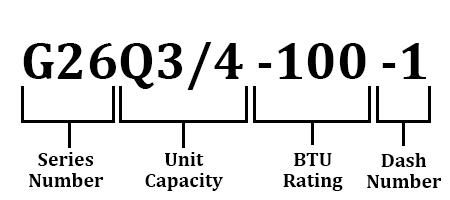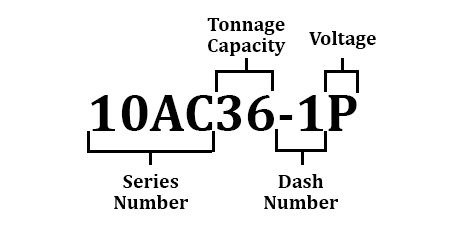The Lennox Model number of your unit is the most important information required in determining the correct replacement part you need.
Each individual unit has its own unique model number which is located on the data plate of the unit. Instruction manuals and service manuals which may have come with your unit do not contain the complete model number required to identify replacement parts (except when the installer actually wrote down the complete model number in them). It is essential that you get the complete model number from you HVAC unit when looking for a replacement part to ensure that you get the exact part that you need to make sure that your system is running smoothly and efficiently throughout the year.
In a residential heating and cooling system there are generally three main components which make up the heating and cooling system: the condensing unit (outside unit), the furnace, and the evaporator coil (both are indoor and generally mounted together). Each of these components have their own unique model number.
Furnace Model Number Breakdown
Different parts of the model number mean different things. Take a G26Q3/4-100-1 for instance. It breaks down in the following way:

Series Number
This is the series number; the G meaning gas (Natural or LP).
Unit Capacity
This is the drive or air capacity of the unit. Here the 3/4 indicates a 3 to 4 ton drive. There are 400 CFM (Cubic Feet Per Minute) of airflow per ton of cooling. The capability of air movement of this example furnace is 1200 to 1600 cubic feet per minute of air. This particular unit can be matched with a 3 to 4 ton condensing unit.
BTU Rating
This is the BTU (British Thermal Unit) rating of the furnace in thousands. This furnace has a BTU input of 100,000 BTUs. The actual output of the furnace depends on its efficiency. This particular furnace is 90% efficient so its BTU output would be .90 x 100,000 or 90,000 BTUs.
Revision (Dash) Number
This is the revision number. Better known as the Dash number. This number indicates a slight revision has occurred to the model series not requiring a series change. Model series can have many revisions over the span of their life. You may see revision numbers as high as 14 or even 18. The revision number is very important in repair part identification as a -1 unit may have a different circuit board than a -8 would.
Condensing Unit Model Number Breakdown
Different parts of the model number mean different things. Take a 10AC36-1P for instance. It breaks down in the following way:

Series Number
This is the series number. The 10 indicates this is a 10 SEER unit, the AC stands for air conditioner (as opposed to heat pump, HP).
Tonnage Capacity
This indicates the tonnage capacity of the unit. There are 12,000 BTUs in a ton of refrigeration capacity. The 36 indicates this unit has a BTU capacity of 36,000 BTUs. 36,000 divided by 12,000 equals 3 tons.
Revision (Dash) Number
This is the revision number. Better known as the dash number. This number indicates a slight revision has occurred to the model series not requiring a series change. Model series can have many revisions over the span of their life. You may see revision numbers as high as 14 or even 18. The revision number is very important in repair part identification as a -1 unit may have a different motor than a -8 would.
Phase or Voltage Requirement
The P indicates the phase or voltage the unit requires. P equals single phase 208-230 volt where a Y would equal 3 phase 208-230 volt or you may see a G which equals a 460 volt unit. Note: Rarely will a residential unit have anything other than a P for single phase.
Model numbers have varied over the years but their general breakdown is consistent for the most part. If you have any issues with finding your model number or determining what it means, don’t hesitate to contact the HVAC professionals here at HVAC Parts Shop. We’ll be more than happy to help you get the information you need and make sure you get the perfect part for your system.
HVACPartsShop.com has posted videos on YouTube to assist you in locating the model numbers:
Our Air Conditioning Model Number location video can be found by clicking here.
Our Furnace Model Number location video can be found by clicking here.
Our Evaporator Coil Model Number location video can be found by clicking here.

